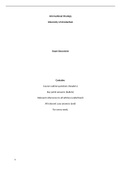International Strategy
University of Amsterdam
Exam Document
Contains:
Course outline questions (headers)
Key point answers (bullets)
Relevant references to all articles (underlined)
All relevant case answers (end)
For every week.
1
,Theme 1
International strategy
a. International strategy entails strategizing why, where, how and
when an MNE should invest cross-border and how it should
consequently manage its subsidiaries to create value and maintain
performance internationally.
What international strategy entails
a. Globalization is the functional integration of economic, cultural, technological
and political activities across borders.
i. Globalization is relevant for MNEs because it may influence
regulations/trade deals, populism, cultural differences, national business
systems/standardization (processes), product adaptation (21 st century
production revolution), etc.
ii. Pressures of globalization are not uniform to all MNEs, which explains the
different types of international strategies.
b. Global value chains (GVC) refer to the interconnectedness of companies’
distribution of innovation systems (intangible assets) and production networks
(tangible assets). For example: a car manufacturer may attain an engine from
Korea and a navigation system from Netherlands.
i. GVCs’ complexity for MNEs arises from geographic and organizational
dispersion of business activities. GVC activities do not only distribute
within an internal network of subsidiaries, but they also involve external
actors. These actors (culture, institution, universities, suppliers) are
distributed in many different locations, leading to high coordination costs.
c. There are 3 main underlying strategic decision drivers about GVC activities.
Namely, the extent of firm-specific advantages (FSAs), country-specific
advantages (CSAs) and internalization advantages (IAs).
i. FSAs are the advantages derived from specific (in)tangible assets which
bring a superior competitive position to the possessing firm. For example:
IKEA’s ready-to-assemble furniture.
1. LB FSA: advantages that create value for the firm (only) if
deployed in a certain location.
2. NLB FSA: advantages which can be transformed from one location
to another within the MNE network.
For example: Unilever has brand recognition and brand power
(NLB FSA), but they also offer local products, which are developed
by adopting the product to local needs and characteristics (LB
FSA).
ii. CSAs are the advantages derived from locating certain activities in a
specific country. For example: companies’ access to oil in Saudi Arabia.
iii. IAs are the advantages derived from keeping activities within the firm
boundaries. For example: Amazon acquisition of Whole Foods kept
physical outlets within organizational boundaries.
iv. These are strongly interconnected, as FSAs are not solely developed in
the home country and may be transferred within the MNE network. CSAs
2
, can contribute to the development of new FSAs and IAs depend on a
company’s transactional FSAs to operate foreign subsidiaries.
The theoretical frameworks that can be used to analyze strategic decision-making
d. Porter (1986) The strategic choices of a firm are determined by the
structure of an industry as well as the forces of competition within in. Porter
views the firm as a combined set of business (primary and support) activities,
represented in the value chain. Competitive advantage of the firm is gained
by carrying out these activities at lower costs and superior coordination
compared to the competitors. To achieve this: “A firm that competes
internationally must decide how to spread the activities in the value chain
among countries”. Combining two dimensions, we can identify 4 strategic
options to compete internationally.
i. Configuration of activities is the extent of geographic concentration or
dispersion.
ii. Coordination of activities is the extent of market or internalization
governance.
e. Ghemawat (2008) The strategic choices of a firm are determined by country
differences. Three strategies can be used to create value by leveraging those
country differences.
i. Adaptation: creating global value by adjusting to differences to meet
local requirements or preferences (local responsiveness). For
example: McDonalds offering Veg McCurry in India.
ii. Aggregation: creating global value by overcoming differences and
exploiting similarities to achieve economies of scale and scope. For
example: Whirlpool’s global integration, following acquisitions.
iii. Arbitrage: creating global value by exploiting country differences to
develop absolute economies of specialization and competitive
advantage. Example: Walmart bought from China to sell products
worldwide with price difference.
3
, f. Bartlett & Ghoshal There are 4 distinct global strategic options, depending on
the degree of interaction across countries (global integration) and the level to
which the firm fine-tuned their operations and offerings (local responsiveness).
Global integration is influenced by country globalization enabling MNEs to break
up their value chains to favorable locations, increased competition (need for
efficiency; economies of scale), the standardization of products and consequent
competition at a global scale. Local responsiveness is influenced by country
differences in consumer tastes across countries, differences in
infrastructure/business practices/distribution channels/etc. and the need to
adjust products to meet local demand. Firms adopt different/similar competitive
strategies in different markets, because competition is similar/fragmented across
borders.
i. International strategy: low pressure for global integration, low
pressure for local responsiveness. For example: Brown Forman (US-
based producer of whisky and other spirits), which does not need to
adapt their (globally recognizable) products to local consumer
demand and faces limited pressure to relocate value chain activities
whilst being internationally present.
ii. Global strategy: high pressure for global integration, low pressure for
local responsiveness. For example: GSK (pharmaceutical) produces
identical medicines for multiple markets, but in a tightly orchestrated
global value chain.
iii. Multi-domestic strategy: low pressure for global integration, high
pressure for local responsiveness. For example: Nestle, which adapt
their product to local tastes by offering different products in different
markets, and their subsidiaries operate relatively autonomously and
fairly independent from the HQ.
iv. Transnational strategy: high pressure for global integration, high
pressure for local responsiveness. For example: Unilever, which
operates an integrated and interdependent network of subsidiaries all
over the world but is locally responsive in downstream activities such
as marketing and sales.
4





